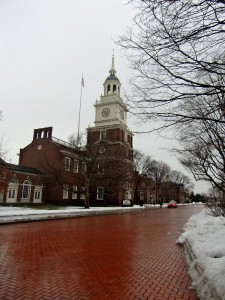IN SEARCH OF SNOW – DEARBORN, MICHIGAN AND THE FORD MOTOR COMPANY
IN SEARCH OF SNOW
This is the sixth in a series of articles about traveling by rail in search of snow
DEARBORN, MICHIGAN AND THE FORD MOTOR COMPANY
By Charles N. Stevens
Photos by Dolores Seidman
We look out our hotel window for our first daylight impression. A very red sun rises in the east among gray clouds. Trees with their bare, iron-dark branches are more like silhouettes, the lawns covered with snow. Piles of snow scooped up by plows rims a parking lot. It is definitely a winter scene and gives us a chill to look at it.
After breakfast we are on our way to the Rouge Ford Plant where we will have a chance to view the assembly of Ford pickup trucks, the Ford-150. One of the first bits of information we learn is that although production is in full swing, the starting pay of new workers is much less than that of the older workers when they started. With unemployment so prevalent, workers will take the lower rate just to have a job.
At first we enter elevators that take us up to the top floor where a room enclosed in glass affords a view in all directions. The dominant view is the vast acreage of the Ford plant, but in the distance the skyscrapers of downtown Detroit rise up into the haze. Some of the roofs of the Ford buildings are planted with flowers and low shrubs as insulation.
Once we enter the assembly plant the noise is upon us—the whines of machines, rattles and clunks and an overall soft roar. Chains and conveyor belts move by with their burdens of truck frames and doors. It’s very colorful, the doors floating by all different colors—black, white, red, silver and gun metal-gray, all shiny and new, glistening in the lights. It is strange to see basic truck bodies passing overhead. Down on the slowly moving assembly line workers install interiors and seats, the lights glistening off the brand new fenders and cabs. Just past this spot a robot with suction cups installs wind shields. We all come away with a good understanding of how trucks are assembled.
When we are outside again the sky is murky and rain has moistened the streets and sidewalks. It hadn’t rained hard enough to melt any of the snow.
We are now on a bus that will take us to the Ford Museum. It is good to sit, although briefly, after we had been standing for hours at the Ford plant. The museum houses so many exhibits that it is difficult to know where to start. Hungry, we decide to pay a visit to the museum café where we have a nice lunch of turkey wraps and hot soup.
Refreshed, we head first to a giant steam locomotive, an Allegheny type once belonging to the Chesapeake and Ohio Railroad, the largest one ever built. This one and others like it hauled coal trains over mountainous routes beginning in the 1930s. The giant engine is now cold and quiet but still imposing. Entering its cab, we sit in the engineer’s seat, seeing what it was like to look ahead down the tracks. Along side this behemoth is the DeWitt Clinton, one of the first locomotives ever built, with its carriage-like cars, looking very small and primitive. It was built in 1831 and was named after the governor of New York who inspired the Erie Canal.
We then move on to a series of long black limousines, the presidential cars of Reagan, Kennedy, (the car in which he was assassinated) Eisenhower and Roosevelt. Nearby is the famous bus in which Rosa Parks refused to move her seat when requested by the bus driver, thereby sparking the Civil Rights movement. Not far away, in marked contrast, is the unique Oscar Mayer Weiner Mobile with its huge metal hot dog on top.
Another section contains a Ford tri-motor airplane as well as one made by Fokker, our very first airliners. Near them, polished and gleaming is a Douglas DC-3, the plane that once became the backbone of our airlines.
Other areas display engines, pumps and farm equipment as well as a section devoted to the legacy of American innovators. Popular is the Dymaxion House, a house of the future as envisioned by Buckminster Fuller.
I should mention that the vast outdoor museum, Greenfield Village, featuring historic houses and buildings as well as a functioning steam railroad is closed in the winter. Today it is buried in snow, but in springtime it will open again for tourists. One of the main attractions is an exact replica of Edison’s Menlo Park laboratory. During the year the village sponsors Civil War reenactments and vintage car shows. Tourists can take a ride in some of the earliest cars.
By the time we leave the Ford Museum the light rain has eaten away at the snow, now exposing patches if the green lawns that were previously hidden beneath it. We are already beginning to miss the snow.

From a rooftop we view the expanse of the Rouge Ford Plant.

On a cold day we are about to enter the Henry Ford Museum.

We are amazed at the size of this Allegheny locomotive once used to haul coal.

One of the early trains looks small compared to the Allegheny locomotive.
MONTEREY PARK AUTHOR PUBLISHES 3RD BOOK ABOUT HIS EXPERIENCES IN WORLD WAR II- BACK FROM COMBAT
Charles “Norm” Stevens, a 40 year resident of Monterey Park and World War II Veteran has recently published the 3rd in his series about his experiences in WW II, Back from Combat: A WWII Bombardier Faces His Military Future. This book details the time from when he returned from combat in England where he flew 34 missions over Germany and France until the end of the war. Faced with large numbers of returning combat vets, and not knowing how long the war would continue, the military had to plan for their future. His options were whether to return to combat, become an instructor in the U.S., or receive new training that he would use in the Pacific. The book concludes with the end of the war with an Afterward that includes an update on the B-l7’s still flying in the U.S., as well as present day accounts pertaining to the war.
Stevens is the author of two previous books about his experiences:
An Innocent at Polebrook: A Memoir of an 8th Air Force Bombardier (Story of his 34 bombing missions from his base at Polebrook, England over Germany and France)
The Innocent Cadet: Becoming A World War II Bombardier (A prequel to the first, telling of his training in the U.S. before going overseas into combat.)
He is known to the readers of The Citizen’s Voice as the author of Travel Log Articles including “From Paris to Normandy on the Seine”, “Exploring New York” and “In Search of Snow.” He is retired, having taught for 32 years, primarily in the Montebello Unified School District.
Those interested in purchasing an autographed copy of any of his books, may contact the author at 323-721-8230 or Normstevens24@gmail.com.



